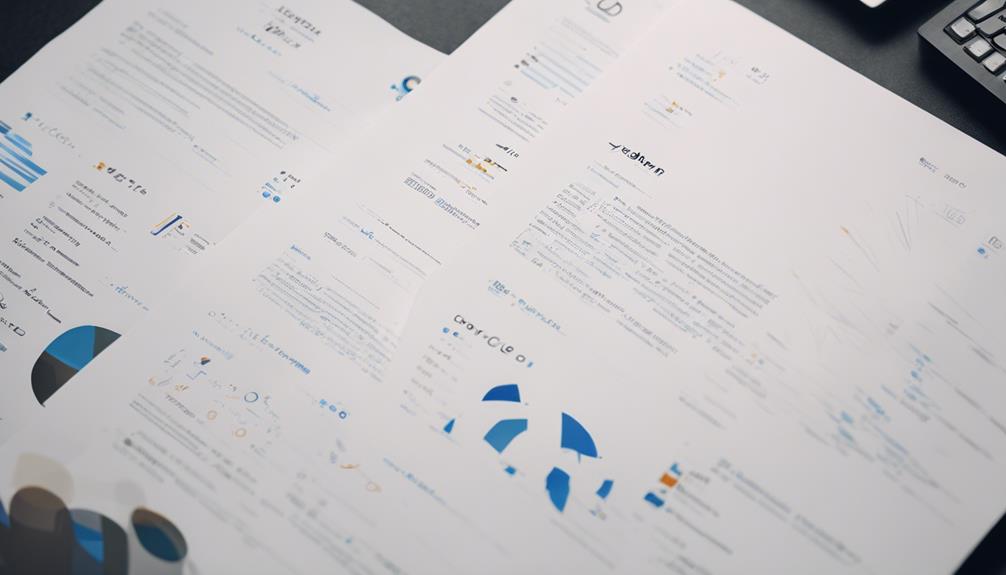Craft your cover letter strategically to stand out in a competitive job market. Tell a compelling story that matches job requirements and shows off your skills and passion. Highlight past experiences with specific examples and differentiate yourself from others. Focus on transferable skills like communication and problem-solving. Tailor the letter to the job you want and express genuine enthusiasm. Personalize it by addressing the hiring manager and aligning with company values. Quantify your achievements and proofread meticulously for a professional touch. Mastering these steps can make your cover letter your secret weapon for landing that dream job.
Key Takeaways
- Craft a narrative aligning with job requirements to engage the reader effectively.
- Showcase transferable skills to differentiate yourself from other candidates.
- Personalize the cover letter by addressing the hiring manager and company values.
- Demonstrate enthusiasm for the role to make a lasting impression.
- Proofread meticulously to convey professionalism and increase credibility.
Crafting a Compelling Story

Craft a compelling narrative in your cover letter to captivate the hiring manager's attention and differentiate yourself from other candidates. Your cover letter should tell a compelling story that showcases your relevant experiences in a way that resonates with the job requirements.
Highlighting your skills, passion for the role, and how your background aligns with what the company is seeking can greatly increase your chances of landing an interview.
When crafting your cover letter, focus on weaving a narrative that not only demonstrates your qualifications but also engages the reader. Share specific examples of how your past experiences have prepared you for the position you're applying for.
Showcasing Transferable Skills

Highlighting transferable skills in your cover letter can significantly enhance your chances of standing out to potential employers and securing opportunities for career advancement. Transferable skills, such as communication, problem-solving, leadership, and time management, are highly sought after by employers across various industries.
When crafting your cover letter, be sure to emphasize these skills to showcase your adaptability and suitability for the role you're pursuing.
Addressing Career Change Directly

When addressing a career shift in your cover letter, focus on the challenges you've faced and how your direct experiences have prepared you for this shift.
Highlighting your ability to overcome industry shifts and adapt to new environments will showcase your readiness for the new role.
Career Change Challenges
Handling career change challenges in your cover letter requires a strategic approach to address your shift directly and emphasize your transferable skills effectively. As career changers, showcasing your transferable skills is vital to demonstrate to employers how your previous experience can benefit the new role.
Personalizing your cover letter by highlighting specific examples of how your skills align with the job requirements can make a significant impact. By weaving a narrative that connects your past experiences to the new role, you can effectively communicate your readiness for the career change.
Crafting a cover letter allows you to tell your story authentically, showcasing your passion for the new role and your enthusiasm to learn. Addressing the challenges of a career change head-on in your cover letter not only shows your commitment but also sets you apart from other applicants.
Employers appreciate candidates who can articulate their motivations and aspirations clearly, making personalized cover letters essential for career changers handling a transition.
Direct Experience Transition
Making a direct statement about your career shift in your cover letter can effectively clarify your move to a new industry or role. By clearly articulating the reasons behind your pivotal change, you demonstrate transparency and honesty to potential employers.
Addressing the career switch head-on shows recruiters your motivation and commitment to the new role. Highlighting transferable skills acquired from previous experiences in your cover letter is vital to showcasing their relevance to the new position despite the career shift.
Crafting a cover letter that emphasizes these transferable skills can make a compelling case for why you're a suitable fit for the role, even without direct experience in the new field. Employers appreciate candidates who can connect the dots between their past experiences and the requirements of the new role, making it essential to showcase how your skills can seamlessly shift to the new industry or position.
Overcoming Industry Shift
To effectively address an industry shift in your cover letter, clearly articulating your reasons for the career change is crucial to capturing recruiters' attention and demonstrating your dedication to the new role.
When crafting your cover letter to overcome an industry shift, consider the following:
- Highlight Transferable Skills: Emphasize the skills from your previous experience that are relevant and adaptable to the new industry.
- Explain Career Change Reasons: Clearly explain why you're changing careers, showcasing a genuine interest and passion for the new field.
- Show Enthusiasm for the New Role: Express your excitement and keenness to contribute to the new industry, illustrating your commitment to succeeding in this change.
- Tailor Your Cover Letter: Customize your cover letter to address the industry shift directly, demonstrating your comprehension of the new field and how you can add value.
Demonstrating Enthusiasm and Passion

Demonstrating enthusiasm and passion in your cover letter can significantly enhance your chances of making a lasting impression on recruiters. When crafting your cover letter, convey genuine interest in the job role and the company's culture. By expressing excitement about the position, you showcase your commitment and motivation to excel in the new role.
Highlight specific examples of why you're enthusiastic about the job to demonstrate your genuine interest in the opportunity. This not only shows your passion for the role but also helps recruiters see how your job skills align with the position's requirements.
Personalizing for Impact

Personalizing your cover letter can greatly enhance your chances of standing out to recruiters and landing an interview opportunity. To maximize your cover letter's impact, consider the following strategies:
- Tailor to the Job Responsibilities: Customize your cover letter to align with the specific job requirements mentioned in the job posting. Highlight how your skills and experiences directly relate to what the position demands.
- Address the Hiring Manager by Name: Whenever possible, address the cover letter to the hiring manager by their name. This personal touch can significantly increase your chances of grabbing their attention.
- Show Understanding of Company Values: Demonstrate a clear understanding of the company's values and culture in your cover letter. This can make you more appealing to employers who are seeking candidates that fit well within their organization.
- Provide Examples of Skill Alignment: Include specific examples of how your skills and achievements match the job responsibilities outlined in the job description. This concrete evidence can demonstrate your qualifications effectively.
Overcoming Common Pitfalls

When crafting your cover letter, steer clear of common pitfalls that can diminish the impact of your application and hinder your chances of securing the desired job opportunity. Avoid using generic cover letter templates that lack personalization and fail to address specific job requirements.
Be sure to proofread your cover letter thoroughly to eliminate any grammatical errors that could detract from your professionalism. It's important to provide new insights and examples in your cover letter to capture the recruiter's interest beyond what's presented in your resume.
Another common mistake to avoid is failing to research the company and industry. Demonstrating genuine interest in the position by incorporating relevant information can set you apart from other applicants.
Lastly, create a cover letter of appropriate length that engages effectively. Make sure it's neither too short nor too long for best impact. By steering clear of these pitfalls, you can enhance the effectiveness of your cover letter and increase your chances of landing the job you desire.
Meeting Employers' Expectations

To meet employers' expectations with your cover letter, focus on addressing specific job requirements and showcasing your genuine interest in the company. Your cover letter showcases how your skills and experiences align with the organization's goals and values.
Here are four key ways to ensure your cover letter aligns with employers' expectations:
- Research the company's mission and values: Tailor your cover letter to demonstrate how your background and aspirations resonate with what the company stands for.
- Highlight relevant achievements: Provide specific examples of how your past accomplishments directly relate to the requirements of the position you're applying for.
- Quantify your impact: Use metrics to quantify the results of your previous work, showcasing your ability to deliver tangible results.
- Show your unique value proposition: Go beyond listing experiences in your resume by explaining how your unique skills make you the ideal candidate for the role.
Crafting a cover letter that meets employers' expectations significantly enhances your chances of securing an interview.
Elevating Achievements With Data

Researching the company's mission and values is an excellent way to tailor your cover letter effectively, but to truly stand out, enhance your achievements with data to showcase your quantifiable impact. Quantifying achievements in your cover letter through specific examples of measurable results is essential. By incorporating specific numbers and figures, you add a level of precision and clarity to your accomplishments, helping recruiters visualize the positive impact you can bring to the role. Demonstrating the quantifiable impact of your achievements not only sets you apart from other candidates but also strengthens your candidacy significantly. Here's an example of how you can present your achievements in a table format to make them more impactful:
| Achievement | Quantifiable Impact |
|---|---|
| Increased sales revenue by 30% | $500,000 |
| Reduced customer wait time by 20% | 15 minutes |
| Implemented cost-saving measures saving 10% | $100,000 |
| Led a team that improved customer satisfaction | 15% increase |
Proofreading for Perfection

Ensure that your cover letter exudes professionalism by meticulously proofreading it for any spelling or grammar errors. Proofreading is an essential step in the cover letter writing process as it guarantees your document is error-free, showcasing your attention to detail.
Here are some key points to keep in mind when proofreading your cover letter:
- Spelling and Grammar: Check for any spelling mistakes or grammatical errors that could detract from the overall quality of your cover letter.
- Professionalism: A well-proofread cover letter conveys professionalism and can leave a positive impression on hiring managers.
- Attention to Detail: Mistakes in your cover letter can diminish your qualifications, so pay close attention to detail during the proofreading process.
- Credibility: Careful proofreading helps you catch typos, punctuation errors, and awkward phrasing that could harm your credibility with potential employers.
Taking the time to review your cover letter demonstrates your commitment to presenting yourself in the best light possible, increasing your chances of securing your desired job.
Frequently Asked Questions
What Is the Biggest Mistake Job Seekers Make When Writing Cover Letters?
Not customizing your cover letter for each job application is the biggest mistake you can make. Recruiters value personalized letters that show genuine interest. Stand out by tailoring your cover letters to the job and company.
What Are the Top Three Things That Should Be in an Impressive Cover Letter?
In your cover letter, highlight relevant skills and experiences for the job. Show understanding of the company's needs and explain how you can meet them. Express enthusiasm for the role and make a strong case for your fit.
How Do You Write a Powerful Cover Letter?
Craft a engaging cover letter by starting with a mesmerizing introduction, showcasing specific achievements, aligning with the job description and company culture, concluding with a call to action, and keeping it concise on one page.
How Do I Write a Cover Letter for a Job Seeker?
To write a cover letter for a job seeker, start by addressing the hiring manager directly. Highlight your relevant skills and experiences that match the job requirements. Quantify your achievements to stand out and increase your chances of getting noticed.
Conclusion
To sum up, crafting an effective cover letter can be the secret weapon that sets you apart from other job seekers. By showcasing your transferable skills, addressing career changes directly, and demonstrating enthusiasm, you can make a strong impression on potential employers.
For example, Sarah, a marketing professional, successfully landed a new role in finance by highlighting her analytical skills and passion for numbers in her cover letter.
Remember, personalized, well-written cover letters can be the key to opening doors to new career opportunities.









